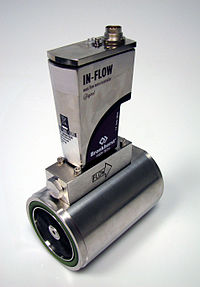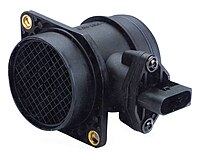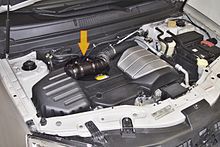Air mass meter
An air mass meter or short LMM (including mass air flow meter (MAF), air mass sensor or LMS) is a in the regulation and metrology inserted flow sensor , the mass of each period by flowing air (the mass flow determined).
The measured mass flow of the air is proportional to the molar amount of the oxygen contained and can therefore be used to control combustion processes, especially in internal combustion engines .
Equivalent to the mass flow is the volume flow related to the normal state of the air or gas.
Obtaining the measurand for combustion processes
The LMM is a particularly in the automotive , gas turbine and condensing technology common mass flow sensor whose output signal is usually in kg / h air or l n is calibrated / min (liters of air at standard conditions per minute). It differs from a volume flow sensor or an anemometer because, in contrast to this, it determines the volume flow related to the normal state of the air.
The measured variable air mass flow of the sensor is u. a. Used in diesel and gasoline engines as well as gas turbines to regulate the amount of fuel injected . Only with the knowledge of the exact air mass can the ratio between air and fuel mass, which is decisive for the combustion process, be set precisely (lambda = 1).
In diesel engines , it also provides a control variable for exhaust gas recirculation .
Many, u. a. Sensors used in motor vehicles today work on the principle of a hot wire anemometer (also known as a hot film air mass meter, abbreviation: HFM) with characteristic curve correction:
The power consumption of heated sensor elements serves as a measured variable. Two differently energized heating elements are kept at a fixed temperature and the electrical power required for this is measured. As the air mass flow increases, the electrical power consumption of the sensor increases. The integrated electronics calculate the values u. a. based on the temperature of the air into a mass flow via a map .
Another method determines the temperature, pressure and flow rate of the air / gas and uses the adiabatic equation of state to calculate the mass flow. This LMM , known as the Karman Vortex air mass meter , determines the flow velocity by means of ultrasonic Doppler anemometry transversely to the air flow swirled for this purpose. No parts of the sensor have to protrude into the intake pipe for this, this method is therefore very reliable.
Micromechanically constructed air mass sensors are also very promising . However, these are more sensitive to contamination and therefore have a shorter service life .
Differentiation of terms and historical development
The LMM is often confused with the older "air flow meter ", which has the same function. With these donors z. B. the sucked in air on a damper which is connected to a potentiometer . The electrical resistance of the potentiometer changes depending on the flow rate . The resistance value is used by the engine control unit to determine the amount of intake air. These air flow meters were z. B. used in the KE-Jetronic . The measurement of the amount of air in the form of the volume does not take into account the temperature, pressure and humidity dependencies of the air flowing through. In addition, it is imprecise due to the mechanical tolerances . This results in less precise control of the amount of fuel.
To control the maximum injection quantity, turbodiesel engines were equipped with a pressure measuring cell that acts mechanically on the injection pump . A line was used as the manipulated variable that picked up the speed-dependent negative pressure between the air filter and the charging turbine.
Construction in cars
The LMM is of great importance for engine management, but is only a comparatively small component.
In the picture above right it is the LMM of a passenger car diesel engine (VAG, year of construction 1995-2003). The sensor itself is located inside the suction pipe. It is attached to a 50 mm long arm that holds it in the middle of the air flow from the suction pipe. During assembly, this arm is inserted into the suction pipe through a fit and screwed to it. A seal prevents secondary air. The electrical contacts are made via a built-in connector (right).
Another design used in motor vehicles is the aforementioned Karman Vortex air mass meter, which has been used by Japanese automobile manufacturers in particular since the early 1980s. At the beginning it usually has a honeycomb grille that calms the air for the following measuring section . In a defined section of the directed air flow there is an ultrasonic measuring section with one or more barriers that swirl the sucked in air according to a specific pattern. The ultrasonic sensors record the noise pattern, whereby the exact air volume flow can be recorded. Complemented by a temperature sensor and a pressure sensor, the currently enforced air mass is determined.
How thermal LMM works
In vehicle internal combustion engines, the LMM encoder is usually positioned behind the air filter in the intake pipe in order to determine the molar mass of air available per unit of time for combustion .
Usual sensors work thermally on the principle of a hot wire anemometer ; Inside the sensor there are two platinum wires or sheet resistors heated by an electric current . One is cooled directly by the air flowing past, the other is shielded.
Both resistance elements heat up due to the electrical current flow, but the intake air flowing past cools the unshielded heating element more than the one shielded from the intake air. This therefore heats up more and becomes more high-resistance .
From the resistance values of the two heating elements and their difference , the following values can be derived by means of a characteristic map taking into account further engine characteristics :
- Intake air temperature
- Air humidity of the intake air
- Mass flow of the intake air (molar mass per time)
After passing the LMM, the intake air is fed to the combustion engine either via the engine supercharger ( turbocharger or compressor ) or directly via the intake pipes, depending on the type of engine .
Significance for engine control
The engine management of modern diesel and gasoline engines in motor vehicles requires the determination of the molar mass of air or oxygen available per cylinder filling in order to determine the maximum amount of fuel to be injected or admixed. The mass flow is not only dependent on the engine speed, but also on the engine temperature, the air temperature and the ambient air pressure .
Furthermore, the autonomously operating exhaust gas turbocharger has a strong influence on the amount of air drawn in, as it is driven by the exhaust gas and therefore needs some time to run up and down. Its delivery rate is not only dependent on the engine speed, but also on the load on the engine.
A regulated exhaust gas purification ( catalytic converter ) requires an oxygen probe ( lambda probe ) and / or an LMM, so that nowadays an LMM is used in almost all vehicles with emission reduction - regardless of whether gasoline or diesel .
Mechanical air flow meters were still used in older motor vehicles. In turbodiesel engines (including Golf II) the z. B. by a (negative) pressure measurement between the air filter and the turbocharger .
Failure / defect
If the LMM fails, the engine control must recognize this defect. This is done using implausible measured values, which then activate a so-called emergency program. Purpose is
- protect the motor from overload
- to protect the environment from unnecessary pollution
- to motivate the driver to visit the workshop by means of the engine control lamp (" Check Engine ") of the on-board diagnosis (OBD) and the possibly reduced engine power .
Failures of the LMM can be promoted by the following events:
- Penetration of spray water through the air filter when driving fast in heavy rain
- Oil vapors flow back from the crankcase ventilation shortly after the engine has been switched off
- Leaks on the clean air side in front of the LMM, whereby the LMM is damaged by sand and other particles ( air filter )
- Usual wear and tear after a long period of use
These events lead to functional impairments in the long term, as foreign substances settle on the measuring element. In practice, the LMM then measures an insufficient intake of air mass. Since this is a main control variable for calculating the injection quantity, less fuel is injected and the engine output is reduced.
At times, slightly incorrect LMM measured values lead to a wide range of symptoms that are not always easy to identify by the driver and workshop. Since minor LMM defects on the part of the engine electronics are not necessarily logged in the fault memory and thus cannot be called up for the workshop via the diagnostic connector, LMM defects on the part of some car dealerships at the beginning of the engine generation with exhaust gas control according to OBD2 / Euro2 / Euro3- Norm can only be localized after extensive error analysis.
Indicators of impaired function are, particularly in the case of diesel engines, reduced performance in the medium speed range. These so-called "pull-through holes" appear at full acceleration, especially in the area of the maximum torque, which is often described as noticeably uneven acceleration in third gear, the maximum power at nominal speed (and thus the top speed) is rarely impaired. In addition, the so-called “weather sensitivity” of the engine (“runs significantly worse when wet”) can occur.
Some passenger car gasoline engines sometimes start to “saw” when the signal is implausible. H. the speed increases in the idle cycle every second and then drops again. But misfiring in connection with poor throttle response and "slapping" in the intake manifold can be an indication of a defective LMM. With some vehicles it is possible to identify the LMM by disconnecting the electrical plug connection. The engine management recognizes the interruption and, based on the stored maps , it can approximately calculate the intake air mass from the engine speed, throttle valve angle , intake air temperature, air pressure and boost pressure . This means that the vehicle runs better than with a defective LMM connected. However, this only works with vehicles whose engine management system does not react to this detected fault with an emergency program.
Self cleaning
LMM, which work on the principle of the hot wire anemometer , are burned free in cars after switching off (not after each) the ignition. For this purpose, the hot wire is briefly heated to approx. 1000 ° C, whereby the dirt particles are evaporated.
literature
- Jürgen Kasedorf: Motor vehicle engine test, gasoline engines. 7th revised edition, Vogel Buchverlag, 1997, ISBN 3-8023-0461-6 .
- Wilfried Staudt: Handbook Vehicle Technology Volume 2. 1st edition, Bildungsverlag EINS, Troisdorf, 2005, ISBN 3-427-04522-6 .
See also
Web links
- Air mass sensors. (PDF) Malfunctions, damage and testing. In: Service information. Pierburg, archived from the original on September 29, 2007 ; Retrieved April 2, 2016 .
- Karman Vortex air mass meter. (PDF) Archived from the original on September 29, 2007 ; Retrieved April 2, 2016 .
Individual evidence
- ↑ Bosch Kraftfahrtechnisches Taschenbuch, 25th edition, page 132





